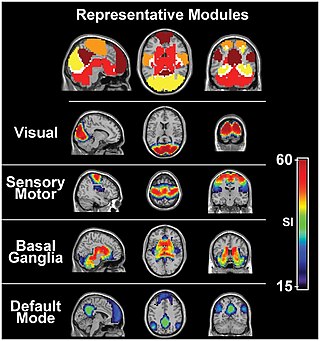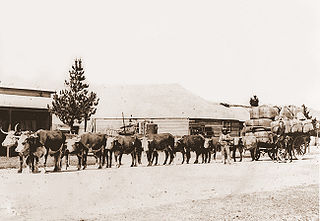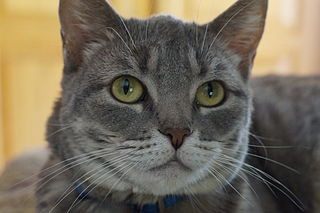
Perception is the organization, identification, and interpretation of sensory information in order to represent and understand the presented information or environment. All perception involves signals that go through the nervous system, which in turn result from physical or chemical stimulation of the sensory system. Vision involves light striking the retina of the eye; smell is mediated by odor molecules; and hearing involves pressure waves.

Predation is a biological interaction where one organism, the predator, kills and eats another organism, its prey. It is one of a family of common feeding behaviours that includes parasitism and micropredation and parasitoidism. It is distinct from scavenging on dead prey, though many predators also scavenge; it overlaps with herbivory, as seed predators and destructive frugivores are predators.

Nocturnality is a behavior in some non-human animals characterized by being active during the night and sleeping during the day. The common adjective is "nocturnal", versus diurnal meaning the opposite.

The sensory nervous system is a part of the nervous system responsible for processing sensory information. A sensory system consists of sensory neurons, neural pathways, and parts of the brain involved in sensory perception and interoception. Commonly recognized sensory systems are those for vision, hearing, touch, taste, smell, balance and visceral sensation. Sense organs are transducers that convert data from the outer physical world to the realm of the mind where people interpret the information, creating their perception of the world around them.

Rattlesnakes are venomous snakes that form the genera Crotalus and Sistrurus of the subfamily Crotalinae. All rattlesnakes are vipers. Rattlesnakes are predators that live in a wide array of habitats, hunting small animals such as birds and rodents.

Animal communication is the transfer of information from one or a group of animals to one or more other animals that affects the current or future behavior of the receivers. Information may be sent intentionally, as in a courtship display, or unintentionally, as in the transfer of scent from predator to prey with kairomones. Information may be transferred to an "audience" of several receivers. Animal communication is a rapidly growing area of study in disciplines including animal behavior, sociology, neurology and animal cognition. Many aspects of animal behavior, such as symbolic name use, emotional expression, learning and sexual behavior, are being understood in new ways.
The Crotalinae, commonly known as pit vipers, or pit adders, are a subfamily of vipers found in Eurasia and the Americas. Like all other vipers, they are venomous. They are distinguished by the presence of a heat-sensing pit organ located between the eye and the nostril on both sides of the head. Currently, 23 genera and 155 species are recognized: These are also the only viperids found in the Americas. The groups of snakes represented here include rattlesnakes, lanceheads, and Asian pit vipers. The type genus for this subfamily is Crotalus, of which the type species is the timber rattlesnake, C. horridus.

Neuroethology is the evolutionary and comparative approach to the study of animal behavior and its underlying mechanistic control by the nervous system. It is an interdisciplinary science that combines both neuroscience and ethology. A central theme of neuroethology, which differentiates it from other branches of neuroscience, is its focus on behaviors that have been favored by natural selection rather than on behaviors that are specific to a particular disease state or laboratory experiment.

A working animal is an animal, usually domesticated, that is kept by humans and trained to perform tasks instead of being slaughtered to harvest animal products. Some are used for their physical strength or for transportation, while others are service animals trained to execute certain specialized tasks. They may also be used for milking or herding. Some, at the end of their working lives, may also be used for meat or leather.
In medicine and anatomy, the special senses are the senses that have specialized organs devoted to them:

Cat senses are adaptations that allow cats to be highly efficient predators. Cats are good at detecting movement in low light, have an acute sense of hearing and smell, and their sense of touch is enhanced by long whiskers that protrude from their heads and bodies. These senses evolved to allow cats to hunt effectively at dawn and dusk.
Prey detection is the process by which predators are able to detect and locate their prey via sensory signals. This article treats predation in its broadest sense, i.e. where one organism eats another.

Visual perception in animals plays an important role in the animal kingdom, most importantly for the identification of food sources and avoidance of predators. For this reason, blindness in animals is a unique topic of study.

The sense of smell, or olfaction, is the special sense through which smells are perceived. The sense of smell has many functions, including detecting desirable foods, hazards, and pheromones, and plays a role in taste.
A sense is a biological system used by an organism for sensation, the process of gathering information about the world through the detection of stimuli. Although in some cultures five human senses were traditionally identified as such, many more are now recognized. Senses used by non-human organisms are even greater in variety and number. During sensation, sense organs collect various stimuli for transduction, meaning transformation into a form that can be understood by the brain. Sensation and perception are fundamental to nearly every aspect of an organism's cognition, behavior and thought.

Vision is an important sensory system for most species of fish. Fish eyes are similar to the eyes of terrestrial vertebrates like birds and mammals, but have a more spherical lens. Birds and mammals normally adjust focus by changing the shape of their lens, but fish normally adjust focus by moving the lens closer to or further from the retina. Fish retinas generally have both rod cells and cone cells, and most species have colour vision. Some fish can see ultraviolet and some are sensitive to polarised light.

In animal physiology, hydrodynamic reception refers to the ability of some animals to sense water movements generated by biotic or abiotic sources. This form of mechanoreception is useful for orientation, hunting, predator avoidance, and schooling. Frequent encounters with conditions of low visibility can prevent vision from being a reliable information source for navigation and sensing objects or organisms in the environment. Sensing water movements is one resolution to this problem.

The chameleon is among the most highly visually-oriented lizards, using this sense in prey capture, mating behavior, and predator avoidance. Unique features of chameleon vision include a negative lens, a positive cornea, and monocular focusing. The development of the chameleon visual system could have evolved to aid in prey capture and/or in predator avoidance.
Most fish possess highly developed sense organs. Nearly all daylight fish have color vision that is at least as good as a human's. Many fish also have chemoreceptors that are responsible for extraordinary senses of taste and smell. Although they have ears, many fish may not hear very well. Most fish have sensitive receptors that form the lateral line system, which detects gentle currents and vibrations, and senses the motion of nearby fish and prey. Sharks can sense frequencies in the range of 25 to 50 Hz through their lateral line.
Sensory tourism is a form of tourism, that caters for people with vision impairment. Those suffering from vision impairment face many difficulties based around mainstream tourism such as access to information, navigation, safety and the knowledge of others around them. This has caused the visionless members of society to travel much less than those with no vision impairment. Combining the theories behind tourism in terms of its psychology and its relation to the senses, an inclusive experience for the visually disabled was developed. Sensory tourism engages the physical and multi-sensory aspects of tourism, enhancing the tourism experience specifically for those with, but also benefitting those without vision impairment.














